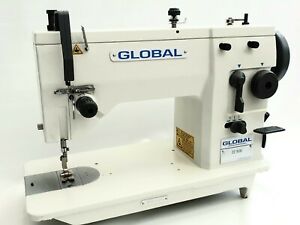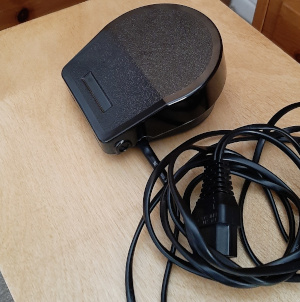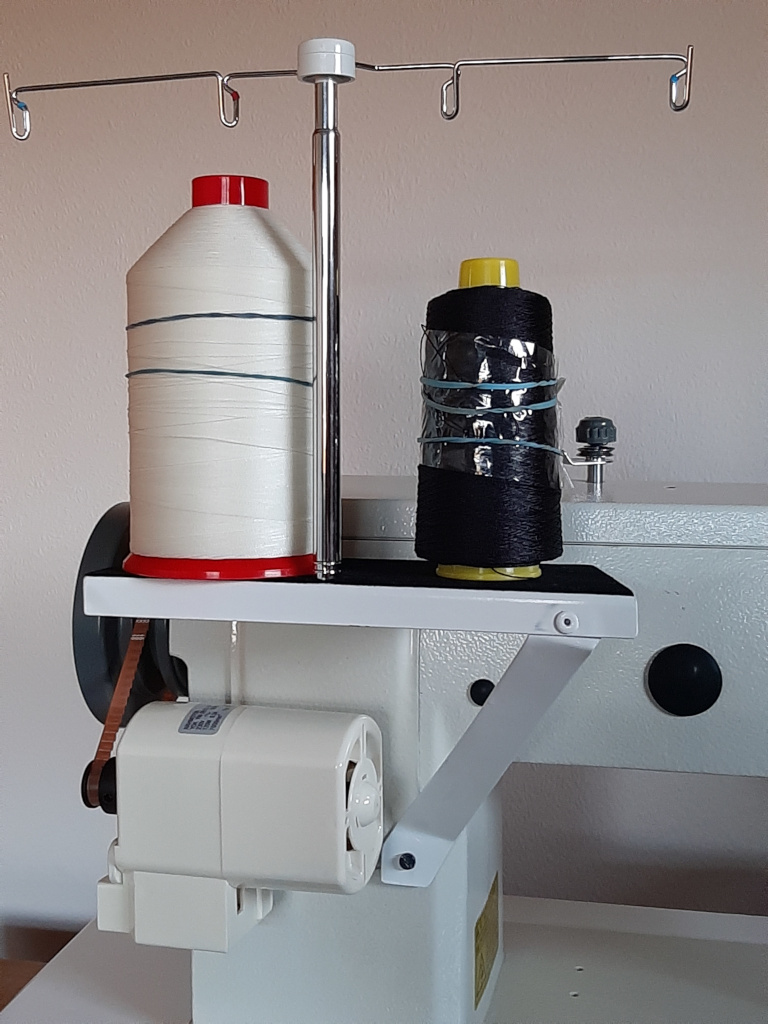Industrial sewing machine conversion
I wanted an industrial duty sewing machine for stitching leather, canvas in many layers etc.
A standard industrial machine with work table, takes up a lot of room whether you are using it or not and is not portable.
The older type, with clutch type motors, are noisy and use a lot of power, designed really for factories running 8 - 12 hrs a day.
I found a dealer who was selling a Singer 20U copy, badged Global.
These are available badged with various makes 'Wilmsew' 'Consew' etc. etc. even Singer still.
The 20U is a 26kg solid cast iron, straight stitch machine with selectable zig zag facility.
Singer moved their production and casting to China at some point, where the same factories or others with copies of the moulds, started creating copies under other names. Intellectual property and copyright are meaningless in China.
Ironically when converting mine and looking at the casting underneath, the original Singer trademark was still present in the casting.
They couldn't even be bothered to remove it.
It was head only, but fitted with a YDK motor at the back of the head, a la every old domestic Singer you have ever seen. I got him to fit the largest motor available (120W instead of the 90W he offered) and bought one.
First job was to make a hinged base.
These heads are usually sunken into a thick, formica topped table so that the bed is flush with the surface, giving a large work area.
At the back they are hinged, so as they can be swung back and out of the table, for bobbin changes and maintainence.
This hinging mechanism is an updated version of that which has existed on Singers since year dot, certainly my 201K I inherited from my mother had round pin hinges.
I wanted my base to be large enough to provide a reasonable extension table around the bed, but allowing it to be fully portable so that I could just pick it up and place it on my worktable, then store it elsewhere when not in use.
I made it from ply and pine, filled, sanded and spray painted gloss white for maximum light (and to match the head).
The feet are 4 door stops, which besides raising the height, allow fingers underneath to aid portabilty.
I made a substantial dust cover box from ply, to completely encase it when not in use.
Next the foot control.
The so called electronic controls supplied with this type of motor are really nothing of the sort, compared to the logic signal electronic controls you see with Bernina, Janome, Pfaff etc.
They are a variable resistor block by which resistance decreases as the pedal is depressed. The YKK one is better than many in quality, but the design of all of them is such that full phase and hence full speed is achieved long before full depression is reached and the resistance is not strictly proportional to amount of pedal depression.
As an interim measure, I introduced a strip of rubber into the pedal mechanism which restricted movement much beyond halfway and made pedal resistance increase with speed.
With a machine capable of running at 2000 spm full speed, this really helps runaway and make it useable.
Next came the peculiar screws and fittings.
Singers had imperial screws, but instead of simply tapping metric threads, the Chinese used horrible cheap steel slot head screws in arcane imperial threads.
For instance, just about every machine in production has 4mm machine bed threads for fixing accessories such as bias binding wrappers, edge fences, hem folders etc. (Some lighter weight have M3, but we are talking industrial machines here)
This one had something like M3.5, but in fact turned out to be 3/16" Whitworth or UNF, can't remember which.
These threads were used on the back access panel and head panel with some 7/32" thrown in elsewhere.
I drilled and tapped the whole lot M4 and used good quality cap head or pan head allen bolts to replace them.
The cheap and nasty needle holder and thread guide, with another cheap and nasty screw to hold the needle, was replaced with the proper thumbscrew Singer unit and likewise the foot retaining slot head screw was replaced with a proper Singer knurled thumbscrew bolt.
I wanted a portable machine, and having a separate thread spool holder does not really fit the bill here.
Besides taking up more space on the worktable, it effectively means re-threading each time you move it or trying to hold it and the machine at the same time.
The original Singer 20U, early in its life had a small double pin spool stand at the back of the head.
I decided that the rear access panel screws were quite well place to support a larger one, and made one capable of taking two 5000 metre M60 spools.
Now I had a fully usable machine, I returned to speed control and power.
I settled upon turning a 7" pulley / handwheel from a solid aluminium round on my lathe.
There is a separate centre core which is keyed on the original shaft keyway and this bolts to the handwheel outer section.
The size necessitated remounting the motor and making a much longer drive belt from weldable conveyor belt drive belting.
This new pulley gave an effective decease in speed and increase in torque of 3.5 to 1.
Additionally, the increased mass of the handwheel added considerable 'flywheel' effect assisting with needle penetration at even quite low speeds.
The machine was now very controllable, quieter and more powerfull given the small motor.
Obviously this is not an option open to many people, but I could not find a commercially available pulley of suitable dimensions and 'what the hell, machines are us'!
I have since seen a company on alibaba selling 20U clones with the same sort of inverter direct variable speed drive seen on many Jack industrial machines and the like.
Had this been available, I would have gone for that, with dial up speed control and a 500W motor, what is to dislike?
But my conversion works very well.






